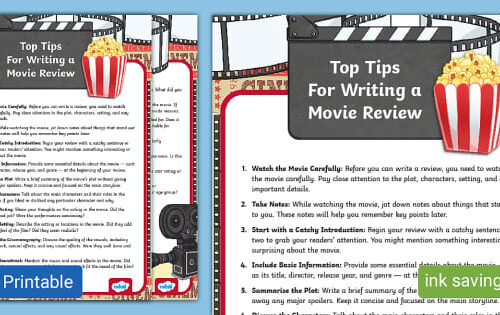Writing a movie review is like telling a friend about a film you just watched—it’s personal, passionate, and packed with your unique perspective. Whether you’re a budding critic or just want to share your thoughts on the latest blockbuster, a well-crafted review can captivate readers and even influence their viewing choices. I’ve been writing reviews for years, from scribbling notes after indie film screenings to posting detailed analyses online, and I’ve learned that a great review balances insight, structure, and a touch of personality. In this guide, I’ll walk you through how to write a movie review that’s engaging, credible, and optimized for readers and search engines alike.
Why Write a Movie Review?
Movie reviews are more than just opinions—they’re a way to guide others through the vast world of cinema. A good review helps readers decide if a film is worth their time, offers fresh perspectives, and can even spark meaningful discussions. Think of it as storytelling with a purpose: you’re sharing your experience while providing value.
The Power of a Personal Touch
When I watched Inception for the first time, I was so blown away by its mind-bending plot that I spent hours jotting down my thoughts. That raw excitement translated into my review, and readers connected with it because it felt real. Your personal reactions—whether it’s awe, frustration, or laughter—are what make your review stand out.
Understanding the Basics of a Movie Review
A movie review is a blend of summary, analysis, and opinion. It’s not just about saying whether you liked the film but explaining why in a way that resonates with your audience. You’ll need to cover the plot (without spoilers), themes, performances, and technical aspects like cinematography or sound design.
Key Elements to Include
Every review should have a clear structure: an introduction, a brief plot summary, your analysis, and a conclusion. Think of it as a roadmap that guides readers through your thoughts without overwhelming them. Keep it concise but impactful.
Plot Summary Without Spoilers
Summarize the story in a way that teases the premise but doesn’t ruin key twists. For example, instead of revealing the ending of The Sixth Sense, you might say it’s a psychological thriller about a boy who sees things others can’t. Less is more here.
Critical Analysis
This is where you dive into what worked (or didn’t). Discuss the acting, directing, writing, or visuals. When I reviewed Mad Max: Fury Road, I focused on its relentless pacing and stunning visuals, which made my critique vivid and relatable.
Your Verdict
Wrap up with a clear opinion. Did the movie move you? Was it a flop? A simple “I loved it” or “Skip it” can suffice, but back it up with reasoning to build trust with your readers.
Step-by-Step Guide to Writing a Movie Review
Ready to craft your review? Follow these steps to create something that’s engaging, structured, and reader-friendly. I’ve broken it down into actionable tips based on my own process, refined over years of reviewing films for blogs and local publications.
Step 1: Watch the Movie Actively
Don’t just sit back with popcorn—watch with a critical eye. Take notes on key moments, like a standout performance or a jarring plot hole. When I watched Parasite, I jotted down how the lighting shifted to reflect class divides, which became a focal point in my review.
Tips for Active Watching
- Note Emotional Reactions: Did a scene make you cry or laugh? Why?
- Track Technical Elements: Pay attention to cinematography, music, or editing.
- Spot Themes: What’s the movie really about? Love, betrayal, redemption?
Step 2: Research the Film’s Context
Understanding the film’s background adds depth to your review. Look up the director’s past work, the cast’s performances, or the film’s cultural impact. For example, knowing Get Out was Jordan Peele’s directorial debut helped me frame its bold storytelling in my review.
Where to Research
- IMDb: For cast, crew, and trivia.
- Rotten Tomatoes: To gauge critical and audience reception.
- Interviews: Check YouTube or podcasts for director or actor insights.
Step 3: Structure Your Review
A clear structure keeps readers engaged. Here’s a simple framework I use:
| Section | Purpose | Word Count |
|---|---|---|
| Introduction | Hook readers, state your opinion | 100–150 |
| Plot Summary | Give a spoiler-free overview | 150–200 |
| Analysis | Discuss themes, acting, technical aspects | 600–800 |
| Conclusion | Summarize your verdict, recommend or not | 100–150 |
This keeps your review balanced and easy to follow.
Step 4: Write with Personality
Your voice is what sets your review apart. When I reviewed La La Land, I shared how its bittersweet ending reminded me of my own dreams and heartbreaks, making the review relatable. Use anecdotes or humor to connect with readers, but don’t overdo it—stay focused on the film.
Dos and Don’ts of Tone
- Do: Be conversational, like you’re chatting with a friend.
- Don’t: Use jargon or overly academic language.
- Do: Share personal reactions to make it authentic.
- Don’t: Ramble about unrelated topics.
Step 5: Edit for Clarity and Flow
After writing, step away for a few hours, then revise. I once wrote a review of Blade Runner 2049 that felt too dry until I trimmed repetitive phrases and added a funny quip about its long runtime. Use tools like Grammarly to catch typos and ensure readability.
Editing Checklist
- Clarity: Is your opinion clear?
- Conciseness: Cut fluff or overly long sentences.
- Flow: Do paragraphs transition smoothly?
Common Mistakes to Avoid
Even seasoned reviewers slip up. Here are pitfalls I’ve learned to dodge:
- Spoilers: Don’t reveal plot twists—it alienates readers.
- Bias: Don’t let personal dislike for a genre cloud your judgment.
- Vagueness: Saying “it was good” without examples is lazy.
- Overloading with Jargon: Terms like “mise-en-scène” can confuse casual readers.
How to Fix These Issues
If you’re tempted to spoil, hint at themes instead. For example, instead of detailing Avengers: Endgame’s climax, I’d mention its emotional weight. If you’re biased against rom-coms, focus on objective elements like pacing or dialogue.
Tools and Resources for Writing Movie Reviews
To elevate your reviews, use these tools and platforms:
| Tool | Purpose | Where to Access |
|---|---|---|
| Grammarly | Grammar and style check | Grammarly.com |
| Hemingway Editor | Improve readability | Hemingwayapp.com |
| Letterboxd | Track films and read reviews | Letterboxd.com |
| IMDb Pro | In-depth film data | IMDb.com |
Best Tools for Beginners
If you’re starting out, Letterboxd is a fun way to share reviews and see what others think. For SEO, tools like Yoast (for WordPress users) can optimize your post for search engines.
Pros and Cons of Writing Movie Reviews
Here’s a quick breakdown to weigh the benefits and challenges:
Pros
- Creative Freedom: Express your unique voice and perspective.
- Engaging Community: Connect with film fans online.
- Monetization Potential: Reviews can attract ad revenue or sponsorships.
- Skill Development: Improves writing, analysis, and critical thinking.
Cons
- Time-Intensive: Watching and writing takes hours.
- Subjectivity: Not everyone will agree with your take.
- Competition: Standing out in a crowded niche is tough.
People Also Ask (PAA) Section
Here are real questions from Google’s PAA for “how to write a movie review”:
How do you start a movie review?
Start with a hook—an intriguing question, a bold opinion, or a personal anecdote. For example, “Ever watched a film that left you speechless? That’s how I felt after Dune.” Then, briefly introduce the movie and your stance.
What makes a good movie review?
A good review is clear, concise, and honest. It balances plot summary, critical analysis, and personal insight. Back up your opinions with examples, like praising an actor’s performance with a specific scene.
How long should a movie review be?
Aim for 500–1,000 words for online reviews. Shorter reviews (200–300 words) work for quick takes, while longer ones (like this article) dive deeper. Match length to your platform and audience.
Can you make money writing movie reviews?
Yes, through blogging with ads (e.g., Google AdSense), affiliate marketing, or freelance writing for publications. Consistency and quality are key to monetization.
FAQ Section
How do I avoid spoilers in a movie review?
Focus on themes, character motivations, or technical aspects without revealing plot twists. Tease the story’s premise in broad strokes, like describing The Matrix as a sci-fi thriller about reality and identity.
What’s the best platform to publish movie reviews?
WordPress or Medium are great for beginners due to their ease of use and SEO features. Letterboxd is ideal for casual reviews, while Substack suits newsletter-style posts.
How do I make my movie review stand out?
Use a unique angle, like comparing the film to real-life experiences or analyzing a niche aspect (e.g., costume design). Add humor or emotional appeal to engage readers.
Do I need to be a film expert to write reviews?
No, but a passion for movies and a willingness to learn help. Researching the film’s context and practicing critical analysis will build your credibility over time.
How can I optimize my review for SEO?
Use keywords like “movie review tips,” “how to write a film review,” or “best movie review examples” naturally. Include internal links to other reviews on your site and external links to credible sources like IMDb.
Conclusion: Craft Reviews That Shine
Writing a movie review is an art that blends analysis, storytelling, and personality. By watching actively, structuring your thoughts, and infusing your voice, you can create reviews that captivate readers and rank well on Google. Whether you’re sharing your love for Star Wars or critiquing an indie gem, your review can inspire others to hit play—or skip it. Start small, experiment with your style, and soon you’ll be crafting reviews that leave a lasting impression. What’s the last movie you watched? Try writing a review and see where your voice takes you!





